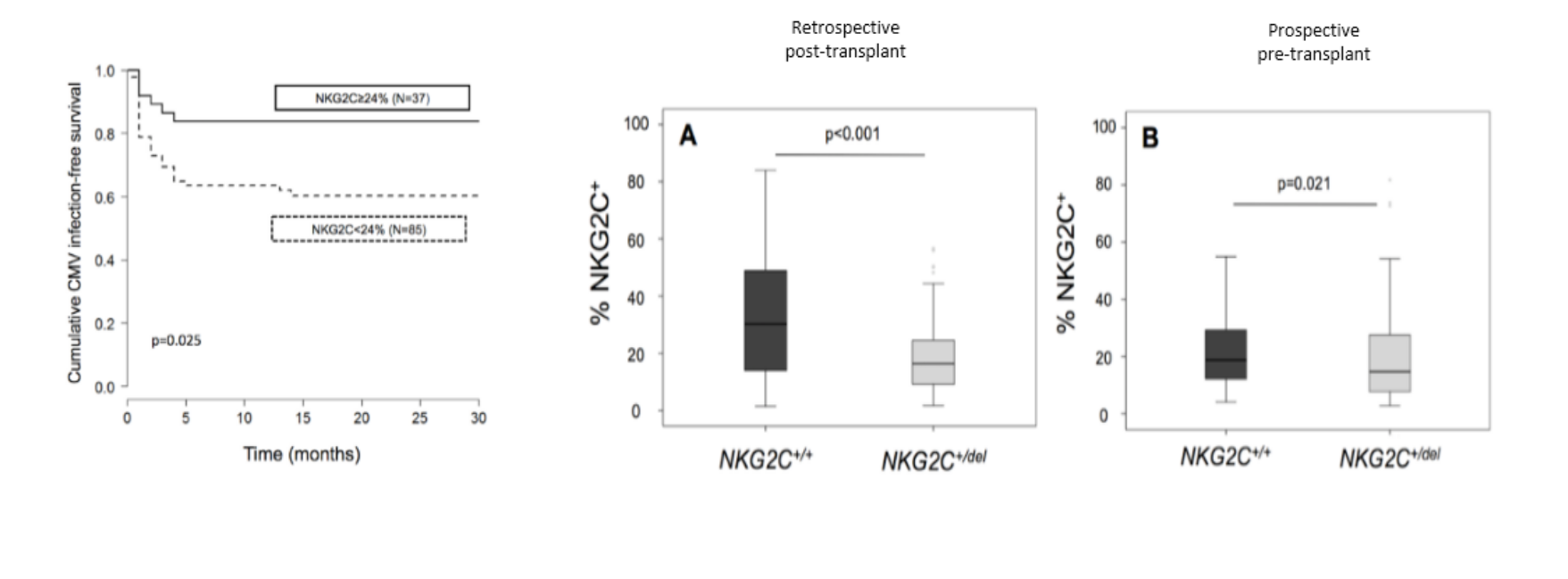NKG2C+ NK Cell Adaptive Response and the Risk of Cytomegalovirus Infection in Kidney Transplant Recipients.
1Departament of Nephrology, Hospital del Mar, Barcelona, Spain
2Departament of Immunology, Hospital del Mar-IMIM, Barcelona, Spain
3Departament of Immunology, Hospital Puerta de Hierro, Barcelona, Spain
Meeting: 2017 American Transplant Congress
Abstract number: A177
Keywords: Kidney transplantation, Natural killer cells
Session Information
Session Name: Poster Session A: Kidney Complications I
Session Type: Poster Session
Date: Saturday, April 29, 2017
Session Time: 5:30pm-7:30pm
 Presentation Time: 5:30pm-7:30pm
Presentation Time: 5:30pm-7:30pm
Location: Hall D1
Cytomegalovirus (CMV) infection in kidney transplant recipients (KTR) has been associated with an increased risk of graft loss and reduced host survival. CMV promotes persistent expansions of NK cells expressing the CD94/NKG2C receptor. The NKG2C (KLRC2) gene is frequently deleted and copy number influences the adaptive response of NKG2C+ NK cells.
The distribution of NKG2C+ NK cells and NKG2C genotypes (NKG2C+/+, NKG2C+/del, NKG2Cdel/del) were studied in cross-sectional (N=253) and prospective (N=122) KTR cohorts. Assessment of CMV viremia was restricted to symptomatic cases in the retrospective study, but was regularly monitored in the prospective cohort.
Overall, the proportions of NKG2C+ NK cells were significantly higher in KTR who had suffered post-transplant symptomatic CMV infection in the cross-sectional study. Yet, along the prospective follow up (3, 6, 12 and 24 months), post-transplant NKG2C+ NK cell expansions were not observed in every patient with detectable viremia who received preemptive anti-viral therapy, suggesting that the adaptive NK cell response may be inversely related with the degree of CMV control. Remarkably, the incidence of post-transplant viremia was reduced among cases with high pre-transplant levels of NKG2C+ NK cells. The NKG2C genotypes distribution was comparable in KTR and healthy controls, and greater proportions of NKG2C+ cells were detected in NKG2C+/+ than in NKG2C+/del patients. Yet, a trend towards increased NKG2C+/del and reduced NKG2C+/+ frequencies associated to symptomatic infection was appreciated in both cohorts.
Our results indirectly support that adaptive NKG2C+ NK cells are involved in the control of CMV in KTR.
CITATION INFORMATION: Redondo D, Crespo M, Yélamos J, Muntasell A, Pérez-Sáez M, Vilchez C, Pascual J, Lóez-Botet M. NKG2C+ NK Cell Adaptive Response and the Risk of Cytomegalovirus Infection in Kidney Transplant Recipients. Am J Transplant. 2017;17 (suppl 3).
To cite this abstract in AMA style:
Redondo D, Crespo M, Yélamos J, Muntasell A, Pérez-Sáez M, Vilchez C, Pascual J, Lóez-Botet M. NKG2C+ NK Cell Adaptive Response and the Risk of Cytomegalovirus Infection in Kidney Transplant Recipients. [abstract]. Am J Transplant. 2017; 17 (suppl 3). https://atcmeetingabstracts.com/abstract/nkg2c-nk-cell-adaptive-response-and-the-risk-of-cytomegalovirus-infection-in-kidney-transplant-recipients/. Accessed December 15, 2025.« Back to 2017 American Transplant Congress
